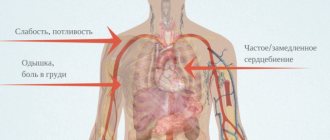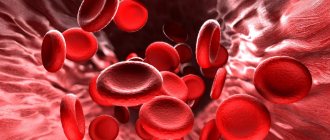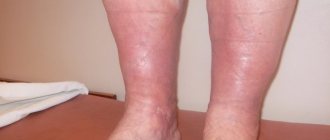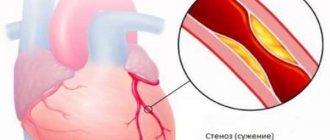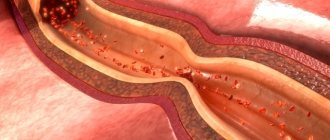Microvascular angina is a pathological inheritance; it is characterized by symptoms of myocardial ischemia; they are formed due to the absence of atherosclerosis of the coronary arteries and spasm of the epicardial coronary arteries on coronary angiography.
The sensation of pain occurs in a person at the moment when the required amount of blood along with oxygen does not enter the heart. Further, the disease develops from damage to large vessels. When arteriosclerotic plaques form, the vessels begin to harden, becoming rigid. The manifestation of the disease is shortness of breath, pain in the heart, rapid heartbeat. In ICD-10, microvascular angina is listed under code I 20.
Who is most often affected by this disease?
Microvascular angina syndrome occurs in patients:
- Having pain in the chest area.
- The stress test of which has a positive result.
- The epicardial coronary arteries are normal and there is no spasm.
- Systemic arterial hypertension is absent along with left ventricular hypertrophy. There are also no disturbances in left ventricular systolic function at rest.
There are cases when patients diagnosed with angina pectoris develop a block of the left bundle branch with the subsequent occurrence of dilated cardiomyopathy. It is important to note that in the absence of changes in the coronary arteries during angiography, occlusive pathology of the distal vessels is observed.
This symptom is considered to be one of the clinical stages of IHD, because myocardial ischemia implies all cases of disruption of oxygen supply and need for it, regardless of the reasons that provoke them.
When diagnosing, it is worth highlighting the antiography method, which assesses the condition of the coronary and microvascular beds, but the assessment possibilities are limited. Based on this, we can conclude that antiographic unchanged coronary arteries indicate the absence of lumen between atherosclerotic plaques in the epicardial arteries. Judging by the anatomical feature, the arteries remain angiographically invisible.
Complications
However, a small proportion of patients may experience relapses of microvascular angina. Moreover, the attacks become prolonged and are less easily controlled by proven medications. Pathological changes occur in the myocardium of a sick person, the contractility of the heart decreases, and heart failure progresses, which seriously complicates a person’s life. Heart rhythm disturbances may be observed, acute myocardial infarction cannot be excluded, and the threat of premature death increases.
A healthy lifestyle will protect against microvascular angina
Causes
Until now, the exact causes of the disease are not completely known. To date, only some pathophysiological processes that contribute to the progression of the disease have been established. These causes of microvascular angina include:
- Increased sympathetic activation.
- Endothelial dysfunction.
- Structural changes.
- Metabolic changes.
- Increased perception of intracardiac pain.
- Severe arterial stiffness.
Other reasons
At the moment, there are many assumptions that help establish the disease. The first assumption suggests that the disease occurs due to anatomical or functional disorders in the vessels that cannot be identified through coronary angiography. The second theory confirms the presence of metabolic changes that provoke a disruption in the synthesis of energy substrates. The third option speaks of an illness that appears due to increased sensitivity to pain symptoms in all organs, including the heart. After conducting a series of thorough studies, scientists were unable to more accurately determine the causes of the disease.
It is only known that the disease is transmitted by middle-aged people, often women. At the same time, half of the patients experience pain in the chest area. A nagging pain appears, which can last from several minutes and last up to several hours.
What is it, microvascular angina?
The cause of angina or chest pain may be coronary microvascular disease, as the WHO calls it, or the so-called syndrome X. The causes of this angina are spasms in the walls of these very small arterial blood vessels of the arterioles. Spasms cause a decrease in blood flow to the heart muscle and lead to a pain syndrome - microvascular angina. Research confirms that men and women not only present with the disease differently, but also develop it differently. It is predominantly a female heart disease and often goes undiagnosed. Is it possible to have heart disease and have healthy coronary arteries? The answer is amazing - YES!
Symptoms of the disease
The main symptom of this disease is pain in the chest area, and most often it occurs during a person’s physical activity. Symptoms can also be triggered by severe cold and emotional turmoil. Nitroglycerin does not help eliminate pain; on the contrary, it aggravates the situation.
Microvascular angina itself occurs as vegetative-vascular dystonia. Very often, angina pectoris is diagnosed in suspicious individuals whose lives are in constant stress and anxiety. Sometimes patients are recommended to undergo a course of mental recovery from a psychologist.
Prevention
Simple preventive measures will help the patient avoid relapse and improve quality of life. Cardiologists recommend following the following rules:
- avoid stressful situations;
- stop smoking and drinking alcohol;
- get rid of extra pounds;
- perform physical exercises;
- regularly measure blood pressure;
- Healthy food;
- control the amount of cholesterol.
Important! Therapy for microvascular angina X is carried out individually. It varies depending on the causes of the disease and the general condition of the patient. Success in treatment directly depends on an integrated approach and compliance with all doctor’s recommendations.
Cardiac syndrome X is a rather complex disease that has not yet been fully understood. It is accompanied by painful attacks that last more than 10 minutes. At the first symptoms, you should immediately consult a cardiologist. The doctor will prescribe a diagnosis and, based on the data obtained, select the best treatment.
Due to the fact that microvascular pathogenesis has not been sufficiently studied and there is no specific treatment method for this type of angina, doctors pay great attention to prevention. Below are recommendations that can significantly reduce the risk of this disease or relapses after a course of therapy for microvascular angina.
- Completely quit smoking, which harms blood vessels.
- Reduce alcohol consumption to 15 milliliters of alcohol per day.
- Reducing alcohol consumption is also important from another point of view - alcohol increases appetite and leads to overeating. Review your diet. Minimize spicy and fried foods, increase the amount of foods rich in fiber (greens, vegetables, fruits).
- Use physical training regularly but in moderation. Walking, swimming, running, and cycling are especially useful. Lesson duration is no more than 41 minutes.
- Control blood pressure and cholesterol levels in the blood.
- Avoid stressful situations whenever possible.
Patients suffering from microvascular angina have a good chance of living a long life.
Preventive measures to stop the development of microvascular angina include a proper diet, leading a healthy lifestyle with moderate physical activity. The patient must avoid stressful situations whenever possible and record an ECG regularly – once every six months (if the person is over 50 years old).
This type of angina, like a typical type of pathology, requires monitoring by the patient and the doctor. The disease cannot be completely cured, and surgical intervention is difficult due to damage to very small vessels. The pathology is generally tolerated by patients if they maintain a healthy lifestyle and take medications prescribed by a specialist.
To prevent the development of microvascular angina, it is enough to adhere to simple preventive measures:
- Lead a healthy lifestyle - give up smoking, drugs and alcoholic beverages.
- Review your diet. You need to consume more vitamins and nutrients found in fresh fruits and vegetables. Avoid fatty and salty foods and cholesterol-rich foods. Give preference to grains and fiber.
- Do physical exercise, do exercises, take walks, visit the pool.
- Breathe fresh air. Even in winter, ventilate the room in the morning and evening before going to bed, sleep with the window slightly open.
- If you have problems with blood pressure, be sure to monitor it daily.
- Avoid stressful situations, do not overstrain your own psyche.
Microvascular angina is not a dangerous disease, but it has serious consequences. You should adhere to preventive measures, but the main thing is to get rid of chronic pathologies in a timely manner and, if signs of angina are detected, consult a specialist.
To reduce the likelihood of relapse of the disease and improve the patient’s quality of life, regular preventive measures are necessary, which include:
- ensuring the patient’s psychological comfort;
- complete ban on smoking;
- minimal consumption or complete abstinence from alcohol;
- fight against excess weight;
- regular moderate physical activity (the load and duration of exercise must be agreed with your doctor);
- blood pressure control;
- rational nutrition;
- regular monitoring of blood cholesterol levels.
We will cover the basics of breathing exercises for angina using the Buteyko method here.
Read about the connection between angina and osteochondrosis here.
Microvascular angina is a complex disease, the causes of which have not yet been established. At the first signs of it, you should consult a doctor for diagnosis and prescribing adequate treatment.
Therapy for the disease is carried out individually, varying depending on the severity and the reasons that caused it. Success in eliminating its symptoms and ensuring a normal quality of life can only be achieved through comprehensive treatment, including medication and a healthy lifestyle.
Due to the fact that microvascular pathogenesis has not been sufficiently studied and there is no specific treatment method for this type of angina, doctors pay great attention to prevention. Below are recommendations that can significantly reduce the risk of this disease or relapses after a course of therapy for microvascular angina.
- Completely quit smoking, which harms blood vessels.
- Reduce alcohol consumption to 15 milliliters of alcohol per day.
- Reducing alcohol consumption is also important from another point of view - alcohol increases appetite and leads to overeating. Review your diet. Minimize spicy and fried foods, increase the amount of foods rich in fiber (greens, vegetables, fruits).
- Use physical training regularly but in moderation. Walking, swimming, running, and cycling are especially useful. Lesson duration is no more than 41 minutes.
- Control blood pressure and cholesterol levels in the blood.
- Avoid stressful situations whenever possible.
How to recognize pain
It is worth talking about the first symptoms and signs of an angina attack. When determining a diagnosis, they look at the following criteria:
- Characteristic pain in the chest area, behavior becomes depressive.
- Ischemic disease in its transient form proceeds without complications.
- The ergometrine test is positive and cardiac output decreases.
- Atherosclerosis is not observed.
- Large amounts of lactate during ischemia, as shown by blood tests.
- Myocardial scintigraphy reveals ischemic disorders.
When microvascular angina occurs, the symptoms are very similar to stable angina. But with this disease, attacks do not occur regularly. In some cases, attacks of angina rest are observed.
To correctly determine the diagnosis, some points must be excluded:
- People with coronary artery spasm are not taken into account.
- Patients with noncardiac causes of chest pain are excluded. For example, this group includes:
- everything related to musculoskeletal diseases: osteochondrosis of the cervical spine;
- neuropsychiatric disorders: depression, anxiety;
- problems with the gastrointestinal tract: ulcers, pancreatitis, high cholesterol, spasms;
- lung diseases: pleural deposits, tuberculosis, pneumonia;
- rheumatological diseases, infections such as syphilis.
Treatment
Due to the complex diagnosis of the disease and completely unexplored causes of its occurrence, treatment methods for syndrome X have not been thoroughly developed. But one thing is clear: timely diagnosis of the disease and recommended therapy give positive results. Treatment is prescribed to the patient individually, depending on the symptoms of the disease and the results of diagnostic studies. Drugs of different groups are prescribed using the selection method. First of all, to relieve pain, the doctor prescribes short-acting nitrates (for example, nitroglycerin). But most often the medicine has no effect. Therefore, the patient is prescribed more effective antianginal drugs (used to relieve angina attacks) in various combinations. The patient is also prescribed medications that reduce the load on the heart muscle.
Diagnostics
To correctly determine the disease, an analysis of the patient’s medical history and complaints is carried out, a survey and examination of the patient is performed. Diagnostic procedures include: blood and urine analysis; blood chemistry; coagulogram; electrocardiography; echocardiography; Holter monitoring of the electrocardiogram; exercise test under ECG control; transesophageal pacing; drug loading tests; stress echocardiography; radioisotope stress tests; coronary angiography; multislice computed tomography.
On the ECG result, angina pectoris will look like this.
The main electrocardiographic diagnostic properties of angina are:
- ST interval displacement;
- changes in the T wave (alignment, downward focus, tall and sharp in shape).
These changes are expressed against the background of an attack, and extremely rarely last from several minutes to hours after the pain has ended. If the reduced ST interval and negative T are maintained longer, it is possible to develop severe focal myocardial degeneration or chronic coronary insufficiency.
The shape of the T wave indicates the depth of the ischemic site.
Ask a doctor
This is a good list of questions to discuss with your doctor:
- What is my risk of developing cardiovascular disease?
- What is blood pressure, is it normal for me?
- What is cholesterol in the blood, is it normal for me?
- What lifestyle should I change (diet, exercise, etc.) or what should I change to prevent cardiovascular diseases?
- Should I get screening tests even if I have no symptoms of heart disease?
- What symptoms should I watch for?
- If I notice these symptoms, what diagnostic tests should I undergo to determine the correct diagnosis?
- How and where can I get diagnostics that are effective in detecting coronary microvascular diseases in our region?
- I have heard that heart disease in women is different from that in men. What is the difference?
- What are the differences in how you diagnose and treat coronary microvascular disease versus coronary artery disease (CAD)?
- How familiar are you with ischemic microvascular disease? Have you treated other patients with the same disease?
- Should I be treated by you or referred to a specialist?
- If the doctor finds confirmation of syndrome X
- How serious is my illness?
- What are the treatment options, benefits, risks and side effects?
- Am I a candidate for myocardial infarction, even after taking medications?
- When should I suspect I'm having a heart attack?
- Should I participate in clinical trials for drugs used to treat Syndrome X?
What is used for therapy
Various treatment options may be used: ACE inhibitors; antianginal agents; angiotensin receptor antagonists; statins; psychotropic drugs.
In turn, antianginal agents, for example, calcium antagonists and beta-adrenergic blockers, are used in patients with diagnosed myocardial ischemia or with impaired myocardial perfusion. If you take sublingual nitrates, they help half of patients with microvascular angina. According to preliminary data, the effectiveness of nicorandil, which has a bradycardic effect, was determined; alpha¹-adrenergic blocker prazoline; L-arginine; ACE indicators: perindopril and enalapril; cytoprotectors – trimetizadine.
